All cells have voltages across their membranes. This voltage is called a(n) __________ and is often maintained by __________.
- iotonic solution; diffusion
- electrochemical gradient; diffusion
- None of the listed responses is correct.
- membrane potential; electrogenic pumps
- concentration gradient; osmosis
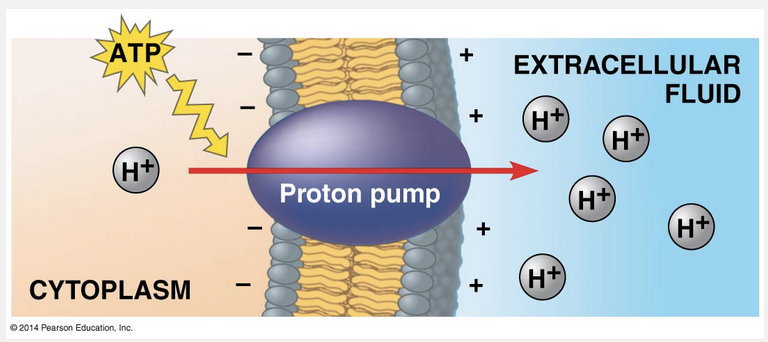
membrane potential; electrogenic pumps
Ex.
The voltage across a membrane is called a membrane potential and is often maintained by electrogenic pumps.
All cells have voltages across their plasma membranes. Voltage is electrical potential energy—a separation of opposite charges. The cytoplasmic side of the membrane is negative in charge relative to the extracellular side because of an unequal distribution of anions and cations on the two sides. The voltage across a membrane, called a membrane potential, ranges from about –50 to –200 millivolts. A transport protein that generates voltage across a membrane is called an electrogenic pump. The sodium-potassium pump appears to be the major electrogenic pump of animal cells. The main electrogenic pump of plants, fungi, and bacteria is a proton pump, which actively transports protons (hydrogen ions, H+) out of the cell.
While the voltage across a membrane is a type of concentration gradient, it is defined more specifically as the membrane potential. Osmosis is not involved in the maintenance of the membrane potential.
Voltages across membranes are not referred to using tonicity as a characteristic. Active transport typically assists in maintaining the voltage.
Membrane potential is based on an electrochemical gradient, but diffusion is not the mechanism that maintains it.
If a red blood cell and a plant cell were placed in seawater, what would happen to the two types of cells?
- The red blood cell would shrink, and the plant cell would gain water.
- Both cells would lose water; the red blood cell would shrivel, and the plant plasma membrane would pull away from the cell wall.
- Both cells would gain water by osmosis; the red blood cell would burst, and the plant cell would increase in turgor pressure.
- Seawater is isotonic to both cells, therefore, neither cell will change as there will be no movement of water into or out of the cells.
- The red blood cell would burst, and the plant cell would shrink.
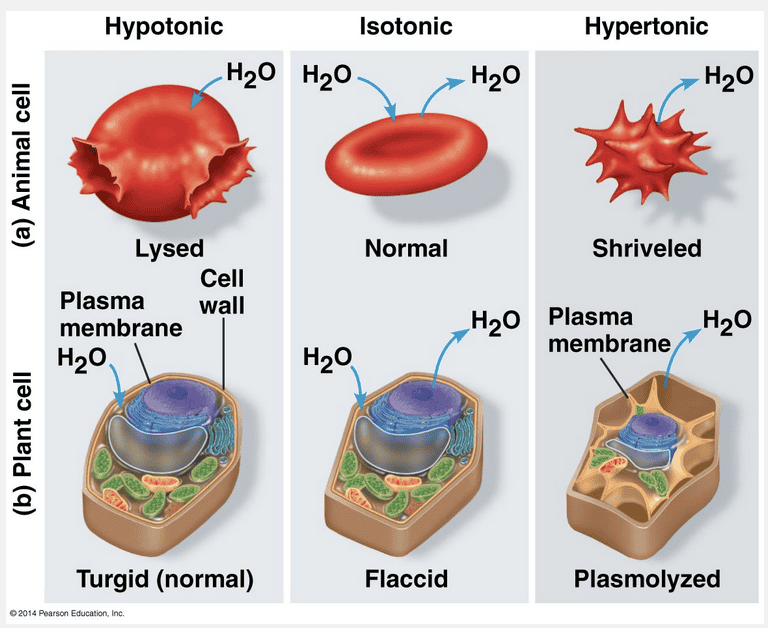
Both cells would lose water; the red blood cell would shrivel, and the plant plasma membrane would pull away from the cell wall.
Ex.
If a red blood cell and a plant cell were placed in seawater, both cells would lose water; the red blood cell would shrivel, and the plant plasma membrane would pull away from the cell wall.
Seawater is hypertonic to both red blood cells and plant cells, and in both cases, water would leave the cells due to osmosis. Both cell types will shrivel. The plant cell will undergo plasmolysis as its cell membrane pulls away from the cell wall.
Because seawater is not hypotonic to these cells, water will not enter the cells.
Which of the following cell structures exhibits selective permeability between a cell and its external environment?
- Chloroplasts
- Plasma membrane
- Endoplasmic
- Mitochondria
- Lysosomes
Plasma membrane
Ex.
The plasma membrane (also called “cell membrane”) exhibits selective permeability between a cell and its watery environment.
The cell membrane is selective in allowing some substances to pass through while excluding or restricting others, a bit like a bouncer at a club who lets in only the pretty girls.
Mitochondria, chloroplasts, and lysosomes are organelles that have membranes, but these membranes do not form the surface of the cell, and each of these organelles has a specific function.
The endoplasmic reticulum is part of the endomembrane system of the cell and is located inside, not on the surface of, the cell.
The sodium-potassium pump __________.
- does not require energy to function
- transports sodium ions out of the cell
- transports glucose into the cell
- transports sodium ions out of the cell and transports potassium ions into the cell
- transports potassium ions into the cell
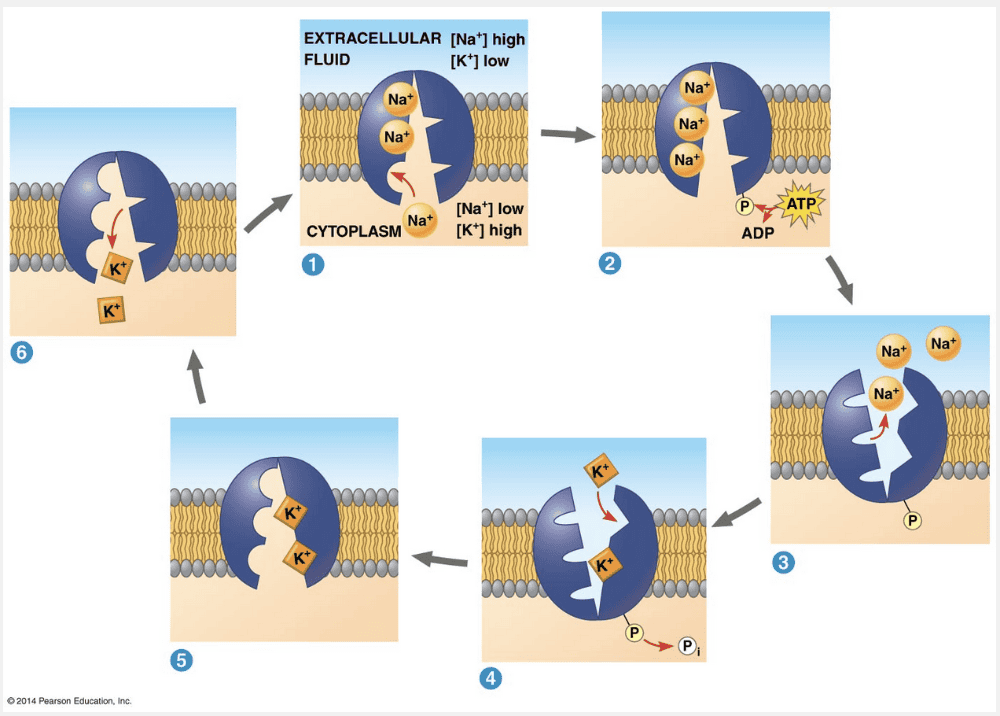
transports sodium ions out of the cell and transports potassium ions into the cell
Ex.
The sodium-potassium pump transports sodium ions out of the cell and transports potassium ions into the cell.
Active transport enables a cell to maintain internal concentrations of small solutes that differ from concentrations in its environment. For example, compared with its surroundings, an animal cell has a much higher concentration of potassium ions (K+) and a much lower concentration of sodium ions (Na+). The plasma membrane helps maintain these steep gradients by pumping Na+ out of the cell and K+ into the cell.
The sodium-potassium pump transports only sodium and potassium ions, not glucose.
The sodium-potassium pump is an active transport mechanism that requires energy to function.
Which of the following is correct regarding peripheral proteins?
- These proteins exhibit both hydrophilic and hydrophobic properties.
- These proteins are found only on the surface of the plasma membrane.
- They exhibit only hydrophobic properties.
- They span the entire phospholipid bilayer.
- They have no specific function in the plasma membrane.
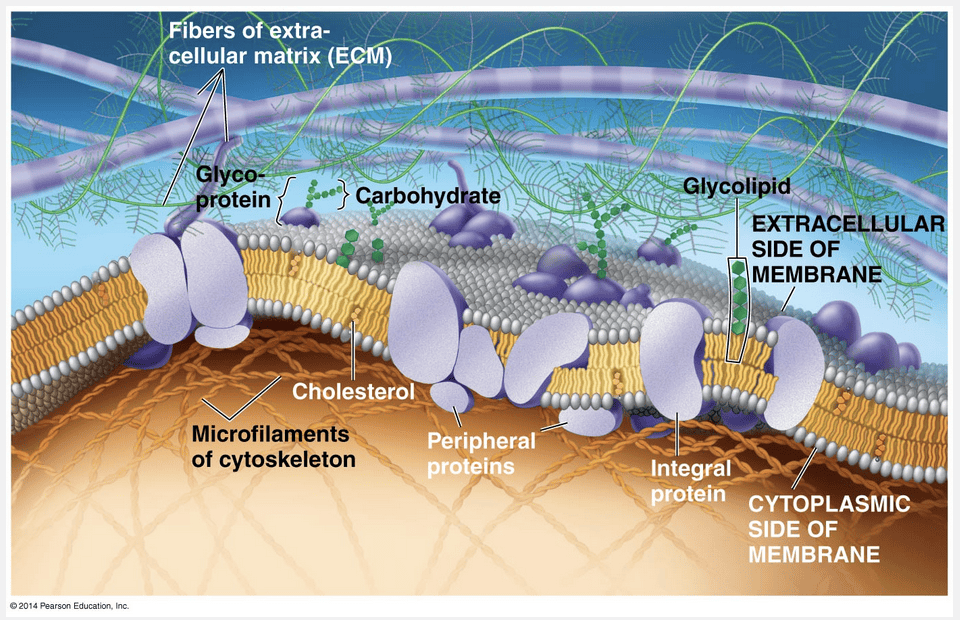
These proteins are found only on the surface of the plasma membrane.
Ex.
Peripheral proteins are found only on the surface of the plasma membrane.
Somewhat like a tile mosaic, a membrane is a collage of different proteins, often clustered together in groups and embedded in the fluid matrix of the lipid bilayer.
Integral proteins penetrate the hydrophobic interior of the lipid bilayer. The majority are transmembrane proteins, which span the membrane; other integral proteins extend only partway into the hydrophobic interior. The hydrophobic regions of an integral protein consist of one or more stretches of nonpolar amino acids, usually coiled into helices. The hydrophilic parts of the molecule are exposed to the aqueous solutions on either side of the membrane.
Peripheral proteins are not embedded in the lipid bilayer at all; they are appendages loosely bound to the surface of the membrane, often to exposed parts of integral proteins.
Peripheral proteins are found on the surface of the plasma membrane and do not span the entire phospholipid bilayer.
Peripheral proteins tend to exhibit only hydrophilic properties.
Peripheral proteins carry out a variety of functions in the plasma membrane.
Peripheral proteins do not tend to exhibit hydrophobic properties.
Which of the following statements about diffusion is true?
- It occurs when molecules move from a region of lower concentration to a region of higher concentration.
- It is very rapid over long distances.
- It is a passive process.
- It always requires integral proteins of the cell membrane.
- It requires expenditure of energy by the cell.
It is a passive process.
Ex.
It is a passive process is true about diffusion.
Diffusion occurs slowly over long distances. It is a passive process that does not require the expenditure of energy by the cell. The molecules of a substance diffuse from an area of higher concentration to an area of lower concentration, spreading out to fill the available space.
Passive diffusion does not depend on the presence of integral proteins; however, facilitated diffusion, which is also a passive process, does.
Why is energy required for active transport?
- To allow the movement of water from a hypotonic solution to a hypertonic solution
- Because it helps maintain water balance in cells without walls
- Because it moves solutes against their concentration gradient
- To allow the movement of solutes down their concentration gradient
- To allow the movement of water from a hypotonic solution to a hypertonic solution

Because it moves solutes against their concentration gradient
Ex.
Active transport requires energy because it moves solutes against their concentration gradient.
Some transport proteins can move solutes against their concentration gradient, across the plasma membrane from the side where they are less concentrated (either inside or outside) to the side where they are more concentrated. To pump a solute across a membrane against its gradient requires work; the cell must expend energy. Therefore, this type of membrane traffic is called active transport. The transport proteins that move solutes against their concentration gradients are all carrier proteins rather than channel proteins.
Active transport moves solutes against their concentration gradient.
Water moves through aquaporins, which are channel proteins, not active transport proteins.
Active transport is not directly involved in water balance in cells.
In facilitated diffusion, __________ proteins provide openings in the plasma membrane for substances to flow through without changing structure, and __________ proteins allow passage of substances through the plasma membrane after undergoing a subtle change in shape.
- active transport; signal transduction
- channel; carrier
- receptor; channel
- peripheral; enzymatic
- carrier; channel
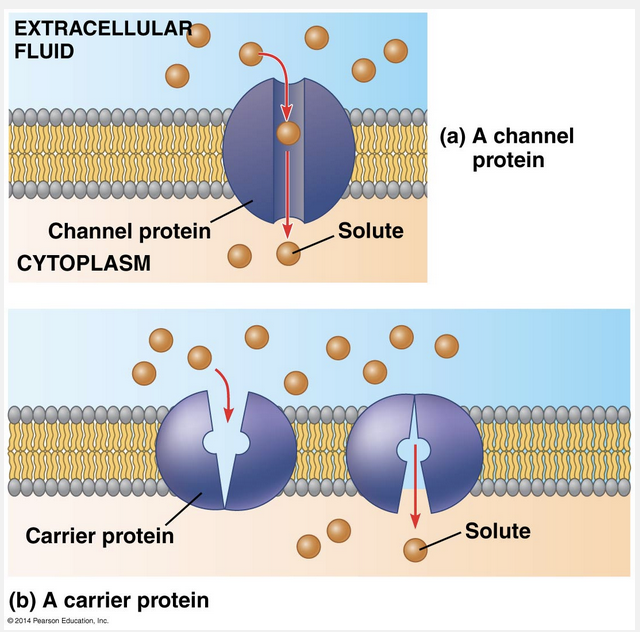
channel; carrier
Ex.
In facilitated diffusion, channel proteins do not undergo changes in shape but carrier proteins do.
Many polar molecules and ions impeded by the lipid bilayer of the membrane diffuse passively with the help of transport proteins that span the membrane. This phenomenon is called facilitated diffusion. The two types of transport proteins are channel proteins and carrier proteins. Channel proteins simply provide corridors that allow specific molecules or ions to cross the membrane. Carrier proteins, such as the glucose transporter mentioned earlier, seem to undergo a subtle change in shape that somehow translocates the solute-binding site across the membrane. Such a change in shape may be triggered by the binding and release of the transported molecule.
Carrier proteins change structure as they allow molecules to flow into or out the cell membrane. Channel proteins do not change structure.
Carrier and channel proteins are not peripheral proteins, nor do they carry out enzymatic functions.
Active transport is not a type of facilitated diffusion, nor is signal transduction.
Receptor proteins bind to molecules to elicit some sort of cellular response. They are not typically involved in facilitated diffusion.
Which of the following statements concerning carbohydrates associated with the plasma membrane is correct?
- Carbohydrates on the plasma membrane are typically short chains of between two and five monosaccharides.
- Carbohydrates associated with the plasma membrane are located on both surfaces of the membrane.
- Membrane carbohydrates function primarily in cell-cell recognition.
- The carbohydrate composition of most eukaryotic plasma membranes is quite similar.
- Carbohydrates are only found associated with the membranes of prokaryotic cells.
Membrane carbohydrates function primarily in cell-cell recognition.
Ex.
The following statement concerning carbohydrates associated with the plasma membrane is correct: Membrane carbohydrates function primarily in cell-cell recognition.
Carbohydrates are associated with the membranes of both prokaryotic and eukaryotic cells. The carbohydrate composition of the plasma membrane varies widely and is the key factor in allowing cells to “recognize” one another.
Carbohydrates are located primarily on the outer surface of the plasma membrane, not on both surfaces. In this location they function primarily in cell-cell recognition (the correct answer). These molecules are usually short, branched chains of fewer than 15 monosaccharides.
Which of the following substances would be most likely to pass through the plasma membrane without the help of a transport protein?
- Water
- A large polar molecule
- Glucose
- A nonpolar molecule, such as a hydrocarbon
- A negatively charged ion
A nonpolar molecule, such as a hydrocarbon
Ex.
A nonpolar molecule, such as a hydrocarbon, would be most likely to pass through the plasma membrane without the help of a transport protein.
Nonpolar molecules such as hydrocarbons, CO2, and O2 are hydrophobic. They can therefore dissolve in the lipid bilayer of the membrane and cross it easily without needing the aid of membrane proteins. However, the hydrophobic interior of the membrane impedes direct passage through the membranes of ions and polar molecules, which are hydrophilic. Polar molecules such as glucose and other sugars pass only slowly through a lipid bilayer, and even water, a very small polar molecule, does not cross rapidly. A charged atom or molecule and its surrounding shell of water are even less likely to penetrate the hydrophobic interior of the membrane. Furthermore, the lipid bilayer is only one aspect of the gatekeeper system responsible for a cell’s selective permeability. Proteins built into the membrane play key roles in regulating transport.
Large polar molecules cannot pass through the plasma membrane without a transport protein due to the hydrophobic properties of the core of the phospholipid bilayer.
Negatively charged ions are repelled by the hydrophobic core of the phospholipid bilayer.
Water is a polar molecule and cannot penetrate the hydrophobic core of the phospholipid bilayer. Aquaporins facilitate the movement of water across the plasma membrane.
Glucose is a large polar molecule and cannot pass through the plasma membrane without a transport protein due to the hydrophobic properties of the core of the phospholipid bilayer.
Which of the following molecules are most abundant in the plasma membrane?
- Carbohydrates
- Proteins
- Phospholipids
- Water
- Cholesterol

Phospholipids
Ex.
Phospholipids are the most abundant molecules in the plasma membrane.
Lipids and proteins are the staple ingredients of membranes, although carbohydrates are also important. The most abundant lipids in most membranes are phospholipids. The ability of phospholipids to form membranes is inherent in their molecular structure. A phospholipid is an amphipathic molecule, meaning that it has both a hydrophilic region and a hydrophobic region.
Proteins are important to the structure of the plasma membrane, but they are not the most abundant component.
Carbohydrates are important to the structure of the plasma membrane, but they are not the most abundant component.
Cholesterol is important to the structure of the plasma membrane, but it is not the most abundant component.
Water is not a component of the plasma membrane.
Which of the following is a correct difference between active transport and facilitated diffusion?
- Active transport can move solutes in either direction across a membrane, but facilitated diffusion can only move in one direction.
- Active transport requires energy from ATP, and facilitated diffusion does not.
- Facilitated diffusion can move solutes against a concentration gradient, and active transport cannot.
- Facilitated diffusion involves transport proteins, and active transport does not.
- Active transport involves transport proteins, and facilitated diffusion does not.
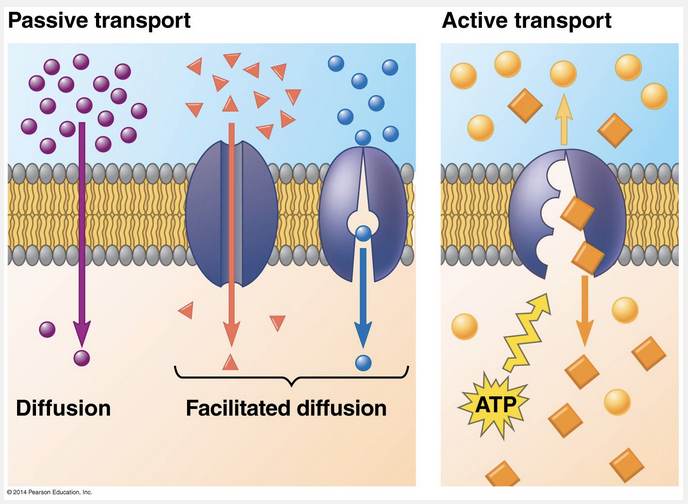
Active transport requires energy from ATP, and facilitated diffusion does not.
Ex.
Active transport requires energy from ATP, whereas facilitated diffusion does not.
Facilitated diffusion requires a concentration gradient across the cell membrane. This process cannot move substances against their concentration gradient; only active transport can do this.
Both active transport and facilitated diffusion use specific membrane transport proteins.
Facilitated diffusion can move substances in either direction across a membrane, depending on the concentration gradient, but active transport move substances only in the direction determined by the properties of the proteins involved.
Both active transport and facilitated diffusion use specific membrane transport proteins.
Facilitated diffusion can move substances in either direction across a membrane, depending on the concentration gradient, but active transport move substances only in the direction determined by the properties of the proteins involved.
Which of the following would be least likely to diffuse through a plasma membrane without the help of a transport protein?
- Any of the above would easily diffuse through the membrane.
- A large polar molecule
- Dissolved gases such as oxygen or carbon dioxide
- A large nonpolar molecule
- A small nonpolar molecule
A large polar molecule
Ex.
A large polar molecule would be the least likely to passively diffuse through a plasma membrane without the help of a transport protein. Both its size and the hydrophobic interior of the membrane would restrict it.
Large nonpolar molecules move across membranes slowly, but this is not the best answer.
Dissolved gases like oxygen and carbon dioxide, and other small nonpolar molecules such as hydrocarbons, pass across cell membranes easily.
Small, nonpolar molecules move easily across the membrane.
Which of the following plant cells would exhibit the most turgor pressure?
- A cell placed in an isotonic solution
- A cell placed in a hypertonic solution
- A cell placed in a hypotonic solution
- None of the listed responses is correct.
- All of the listed responses are correct.
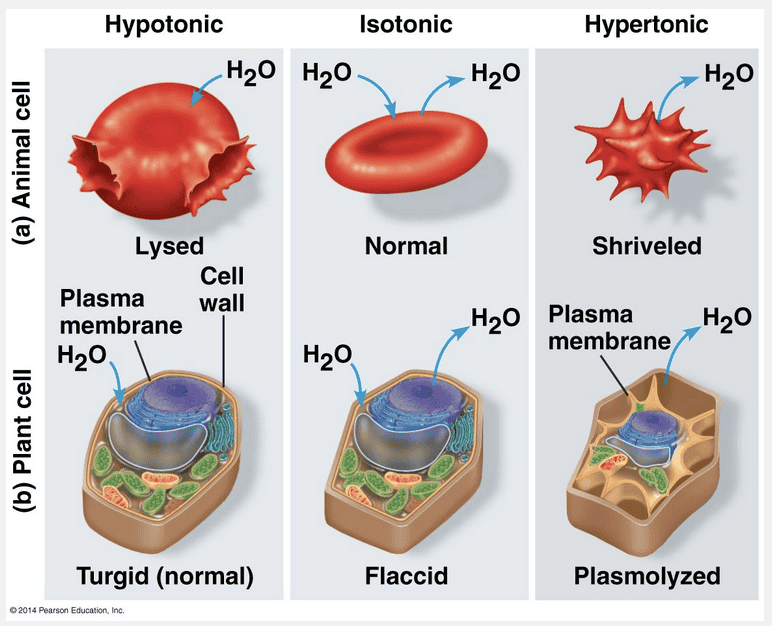
A cell placed in a hypotonic solution
Ex.
In this case, a cell placed in a hypotonic solution would exhibit the most turgor pressure.
In a hypotonic solution, the plant cell would take up water. The cells of plants, prokaryotes, fungi, and some protists are surrounded by cell walls. When such a cell is immersed in a hypotonic solution—bathed in rainwater, for example—the cell wall helps maintain the cell’s water balance. Consider a plant cell. Like an animal cell, the plant cell swells as water enters by osmosis. However, the relatively inelastic cell wall will expand only so much before it exerts a back pressure on the cell, called turgor pressure, that opposes further water uptake. At this point, the cell is turgid (very firm), which is the healthy state for most plant cells. Plants that are not woody, such as most houseplants, depend for mechanical support on cells kept turgid by a surrounding hypotonic solution. If a plant’s cells and their surroundings are isotonic, there is no net tendency for water to enter, and the cells become flaccid (limp).
A plant cell placed in an isotonic solution would exhibit lower turgor pressure and be flaccid.
A plant cell placed in a hypertonic solution would lose water and become plasmolyzed.
A cell is placed into a solution and the cell shrinks. Which of the following is true regarding the solution?
- The solution is hypotonic.
- The cell is hypertonic.
- The solution is hypertonic.
- None of the listed responses is correct.
- The solution has the same solute concentration as the cell.

The solution is hypertonic.
Ex.
The solution is hypertonic.
To explain the behavior of a cell in a solution, we must consider both solute concentration and membrane permeability. Both factors are taken into account in the concept of tonicity, the ability of a surrounding solution to cause a cell to gain or lose water. The tonicity of a solution depends in part on its concentration of solutes that cannot cross the membrane (nonpenetrating solutes) relative to the concentration inside the cell. If there is a higher concentration of nonpenetrating solutes in the surrounding solution, water will tend to leave the cell, and vice versa.
Since the cell shrinks, the concentration of the solution cannot be the same as that in the cell.
If the solution were hypotonic, the cell would increase in size.
If the cell were hypertonic, it would increase in size.
Which of the following is correct regarding integral proteins?
- They exhibit only hydrophobic properties.
- They have no specific function in the plasma membrane.
- These proteins exhibit both hydrophilic and hydrophobic properties.
- They exhibit only hydrophilic properties.
- These proteins are found only on the surface of the plasma membrane.
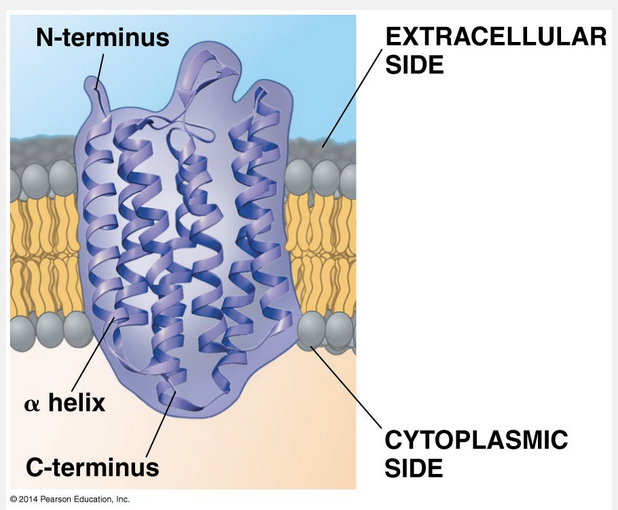
These proteins exhibit both hydrophilic and hydrophobic properties.
Ex.
These proteins exhibit both hydrophilic and hydrophobic properties.
Somewhat like a tile mosaic, a membrane is a collage of different proteins, often clustered together in groups and embedded in the fluid matrix of the lipid bilayer. Integral proteins penetrate the hydrophobic interior of the lipid bilayer. The majority are transmembrane proteins, which span the membrane; other integral proteins extend only partway into the hydrophobic interior. The hydrophobic regions of an integral protein consist of one or more stretches of nonpolar amino acids, usually coiled into helices. The hydrophilic parts of the molecule are exposed to the aqueous solutions on either side of the membrane.
Peripheral proteins are found on the surface of the plasma membrane.
Integral proteins exhibit both hydrophilic and hydrophobic properties.
Integral proteins carry out a variety of functions in the plasma membrane.
How does cholesterol affect membrane fluidity?
- At lower temperatures, it makes the membrane more fluid.
- It has no effect on membrane fluidity.
- At body temperature, it makes the membrane more fluid.
- At body temperature, it makes the membrane less fluid.
- It allows phospholipids to pack tightly together.
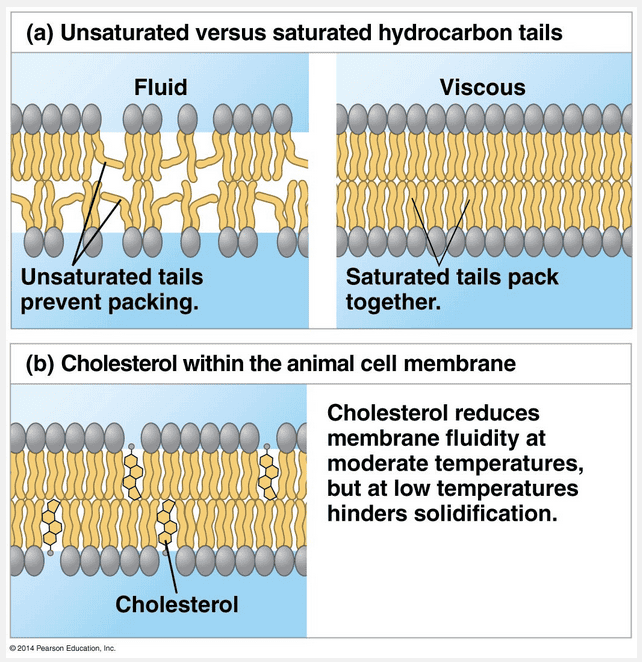
At body temperature, it makes the membrane less fluid.
Ex.
Cholesterol affects membrane fluidity significantly, and at body temperature, it makes the membrane less fluid.
Hydrocarbon tails make the membrane more fluid. The steroid cholesterol, which is wedged between phospholipid molecules in the plasma membranes of animal cells, has different effects on membrane fluidity at different temperatures. At relatively high temperatures—for example, at 37°C, the body temperature of humans—cholesterol makes the membrane less fluid by restraining phospholipid movement. However, because cholesterol also hinders the close packing of phospholipids, it lowers the temperature required for the membrane to solidify. Thus, cholesterol can be thought of as a “fluidity buffer” for the membrane, resisting changes in membrane fluidity that can be caused by changes in temperature.
Cholesterol exhibits a variety of effects on membrane fluidity.
Cholesterol makes the membrane less fluid at body temperature.
Cholesterol in the membrane resists fluidity changes at lower temperatures.
Cholesterol disrupts the regular packing of phospholipids in the membrane.
Which of the following structural arrangements of the components in biological membranes facilitates the cell membrane's property of selective permeability?
- Phospholipids sandwiched between two layers of protein
- Proteins sandwiched between two layers of phospholipids
- A layer of protein coating a layer of phospholipid
- Proteins embedded in two layers of phospholipids
- A phospholipid bilayer with proteins scattered on the surfaces of the membranes
Proteins embedded in two layers of phospholipids
Ex.
The following structural arrangements of the components in biological membranes facilitate the cell membrane's property of selective permeability: Proteins embedded in two layers of phospholipids.
The question asks you to determine the arrangement of proteins in the cell membrane that would best facilitate its selective permeability. Selective permeability requires that the membrane allow some, but not all, substances to cross it. Proteins sandwiched between two layers of phospholipid would not allow polar solutes to cross. Proteins embedded in two layers of phospholipids allow them to play their role in selective transport of polar molecules.
A layer of protein coating a layer of phospholipids would prevent most polar molecules from crossing the membrane.
Similarly, phospholipids sandwiched between two layers of protein, or a phospholipid bilayer with proteins scattered on the surface of the membranes, would prevent or restrict the passage of polar solutes.
Red blood cells contain approximately a 2% concentration of solutes. A red blood cell is placed into a solution that contains a 4% concentration of solutes to which the cell is not permeable. What will happen to the red blood cell?
- The cell will decrease in size as water flows out of it.
- The solutes will diffuse into the cell.
- The cell will increase in size as water flows into it.
- The solutes will diffuse out of the cell.
- Nothing will happen because the solution and the cell are isotonic to each other.

The cell will decrease in size as water flows out of it.
Ex.
In this solution, the cell will decrease in size as water flows out of it.
Since the concentration of solutes in the solution is higher than that in the cell, the cell is in a hypertonic environment. Cells lose water in this type of environment. To explain the behavior of a cell in a solution, we must consider both solute concentration and membrane permeability. Both factors are taken into account in the concept of tonicity, the ability of a surrounding solution to cause a cell to gain or lose water. The tonicity of a solution depends in part on its concentration of solutes that cannot cross the membrane (nonpenetrating solutes) relative to that inside the cell. If there is a higher concentration of nonpenetrating solutes in the surrounding solution, water will tend to leave the cell, and vice versa.
Since the concentration of solutes in the solution is higher than that in the cell, the cell will lose water.
The cell will lose water and decrease in size. It will not increase in size.
The question stated that the cell is not permeable to the solutes in the solution, so the solutes will not diffuse into or out of the cell.
How does the “fluid mosaic model” describe the structure of the plasma membrane?
- Only the proteins in the membrane contribute to its fluidity.
- The plasma membrane is a rigid structure that exhibits little flexibility.
- None of the listed responses is correct.
- Proteins in the membrane contribute to the mosaic quality of the membrane while the lateral and rotational movements of phospholipids contribute to its fluidity.
- The fluid characteristic is due to the presence of carbohydrates, and the mosaic characteristic is due to the presence of phospholipids.

Proteins in the membrane contribute to the mosaic quality of the membrane while the lateral and rotational movements of phospholipids contribute to its fluidity.
Ex.
Proteins in the membrane contribute to the mosaic quality of the membrane while the lateral and rotational movements of phospholipids contribute to its fluidity.
Lipids and proteins are the staple ingredients of membranes, although carbohydrates are also important. Like membrane lipids, most membrane proteins are amphipathic. Such proteins can reside in the phospholipid bilayer, with their hydrophilic regions protruding. This molecular orientation maximizes contact of hydrophilic regions of proteins with water in the cytosol and extracellular fluid, while providing their hydrophobic parts with a nonaqueous environment. In this fluid mosaic model, the membrane is a mosaic of protein molecules bobbing in a fluid bilayer of phospholipids.
The plasma membrane exhibits a fluid, not a rigid, structure.
The fluid characteristic is due to the lateral and rotational movements of phospholipids, not carbohydrates. Proteins in the membrane contribute to the mosaic characteristic.
Although proteins in the membrane can move somewhat within the phospholipid bilayer, the lateral and rotational movements of the phospholipids are what primarily contribute to its fluidity.
Which of the following molecules is most likely to passively diffuse across the plasma membrane?
- Glucose
- Hemoglobin
- Carbon dioxide
- Sodium ion
- DNA
Carbon dioxide
Ex.
Carbon dioxide is most likely to passively diffuse across the plasma membrane.
Nonpolar molecules like carbon dioxide, hydrocarbons, and oxygen are hydrophobic and dissolve in the lipid bilayer, crossing the cell membrane easily through passive diffusion. Ions and polar molecules, however, are hydrophilic and cannot cross the hydrophobic interior of the membrane without a carrier.
Glucose is a polar molecule that is covered in water; it requires a transport protein to cross a membrane.
Sodium ion is positively charged and also requires a transport protein. DNA is a large charged molecule: it, too, cannot cross the membrane easily.
Hemoglobin, too, is large, and this protein does not normally cross the cell membrane.
The plasma membrane exhibits selective permeability. This means that __________.
- the plasma membrane allows any substance to flow through it easily
- the structure of the plasma membrane does not affect its permeability
- proteins in the membrane do not affect its permeability
- the plasma membrane allows some substances to flow through it more easily than others
- the plasma membrane does not allow any substance to flow through it

the plasma membrane allows some substances to flow through it more easily than others
Ex.
The plasma membrane exhibits selective permeability. This means that the plasma membrane allows some substances to flow through it more easily than others.
Like all biological membranes, the plasma membrane exhibits selective permeability; that is, it allows some substances to flow through it more easily than others. The ability of a cell to discriminate in its chemical exchanges with its environment is fundamental to life, and it is the plasma membrane and its component molecules that make this selectivity possible.
It is not true that the plasma membrane does not allow any substance to flow through it. Rather, it allows some but not all substances to flow through it freely.
The structure of the plasma membrane is directly related to its selective permeability.
Proteins in the membrane have a significant impact on its selective permeability.
What function do carbohydrates fulfill in the plasma membrane?
- They contribute to its selective permeability.
- Cell-to-cell recognition
- Transport of molecules across the membrane
- They facilitate enzymatic processes.
- They contribute to its “fluid” characteristic.
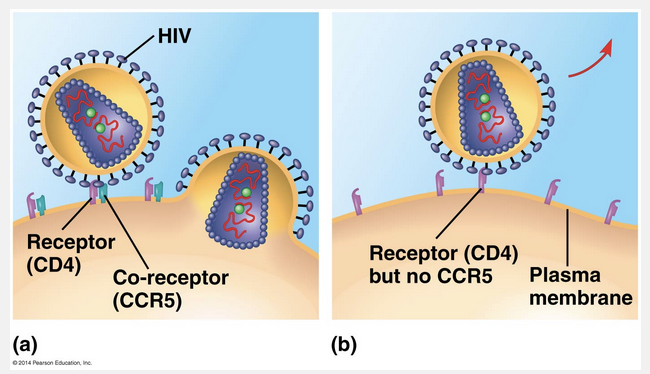
Cell-to-cell recognition
Ex.
Carbohydrates in the plasma membrane facilitate cell-to-cell recognition.
Cell-to-cell recognition, a cell’s ability to distinguish one type of neighboring cell from another, is crucial to the functioning of an organism. It is important, for example, in the sorting of cells into tissues and organs in an animal embryo. It is also the basis for the rejection of foreign cells by the immune system, an important line of defense in vertebrate animals. Cells recognize other cells by binding to molecules, which often contain carbohydrates, on the extracellular surface of the plasma membrane. Membrane carbohydrates are usually short, branched chains of fewer than 15 sugar units. Some are covalently bonded to lipids, forming molecules called glycolipids. (Recall that glyco refers to the presence of carbohydrates.) However, most are covalently bonded to proteins, which are thereby glycoproteins.
Proteins are usually associated with the transport of substances across the plasma membrane.
Carbohydrates do not contribute to the selective permeability of the plasma membrane.
Proteins are usually associated with any enzymatic activity that occurs on the plasma membrane.
Phospholipids contribute to the “fluid” characteristic of the plasma membrane.
Which of the following statements about passive transport is correct?
- In passive transport, solute movement stops when the solute concentration is the same on both sides of the membrane.
- Passive transport operates independently of the concentrations of the moving solute.
- Passive transport does not occur in the human body.
- Passive transport permits the solute to move in either direction, but the net movement of the population of solute molecules occurs down the concentration gradient of the molecule.
- Passive transport operates independently of diffusion.
Passive transport permits the solute to move in either direction, but the net movement of the population of solute molecules occurs down the concentration gradient of the molecule.
Ex.
Passive transport permits the solute to move in either direction, but the net movement of the population of solute molecules occurs down the concentration gradient of the molecule.
Passive transport is the diffusion of a solute across a biological membrane. Substances must diffuse from an area of higher concentration to an area of lower concentration, referred to as “down” the concentration gradient. Passive transport continues even when the concentration of solute is the same on both sides of the membrane: in this case, the rate of transport is the same in both directions. It is a fundamentally important process in the human body, with oxygen, water, and carbon dioxide, among many other substances, transported in this way. Passive transport allows solute molecules to move in either direction, but the net movement of solute molecules occurs down the concentration gradient.
The internal solute concentration of a plant cell is about 0.8M. To demonstrate plasmolysis, it would be necessary to suspend the cell in what solution?
- 150m
- 1.0M
- distilled water
- 0.8M
- 0.4M
1.0M
Ex.
The internal solute concentration of a plant cell is about 0.8M. To demonstrate plasmolysis, it would be necessary to suspend the cell in a 1.0M solution.
Plasmyolysis refers to the shriveling of plant cells when they are placed in a hypertonic environment. Surrounded by a high concentration of non-penetrating solutes, the plant cells lose water to the environment and shrink. The plasma membrane pulls away from the cell wall, leading to wilting and possible death.
Distilled water is hypotonic to the plant: in such a solution, water will enter the cells, leading to turgor.
For a plant with an internal solute concentration of 0.8M, a solution of 0.4M is hypotonic, leading to increased turgidity. A solution of 0.8M is isotonic to the plant cell, which will become flaccid if immersed, but plasmolysis will not occur.
A 1.0M solution is hypertonic to the plant cell and will cause plasmolysis.
A 150m solution is the same as a 0.15M solution, which is hypotonic to the plant cell.
Which of the following processes and organelle(s) accounts for the replacement of lipids and proteins lost from the plasma membrane?
- Exocytosis and smooth and rough ER
- Receptor-mediated endocytosis and smooth ER and Golgi
- Endocytosis and Golgi
- Active transport and the rough endoplasmic reticulum
- Flip-flop of phospholipids from one side of the plasma membrane to the other and the Golgi
Exocytosis and smooth and rough ER
Ex.
Exocytosis and smooth and rough ER accounts for the replacement of lipids and proteins lost from the plasma membrane.
Exocytosis and the smooth and rough ER play important roles in replacing lipids and proteins in the cell membrane. Exocytosis is the process whereby transport vesicles move to the cell membrane and fuse with it as they release their contents into the extracellular space, leading to the replacement of cell membrane phospholipids. The smooth ER produces lipids destined for the membrane, whereas the rough ER produces proteins destined for the plasma membrane.
In endocytosis, phospholipids are removed from the cell membrane as new vesicles are formed by budding (the Golgi apparatus does ship phospholipids to the plasma membrane, however).
Active transport does not move phospholipids to the cell membrane, nor is the rough ER involved in the synthesis of phospholipids.
Receptor-mediated endocytosis results in the loss of phospholipids from the membrane, and neither the smooth ER nor the Golgi apparatus makes replacement proteins.
Phospholipids do not normally flip-flop from one side of the plasma membrane to the other, and in any event, such movements would not increase the area of the membrane.
Which of these statements describes some aspect of facilitated diffusion?
- Facilitated diffusion of solutes may occur through channel or transport proteins in the membrane.
- There is only one kind of protein pore for facilitated diffusion.
- Facilitated diffusion requires energy to drive a concentration gradient.
- Facilitated diffusion is another name for osmosis.
- Facilitated diffusion of solutes occurs through phospholipid pores in the membrane.
Facilitated diffusion of solutes may occur through channel or transport proteins in the membrane.
Ex.
Facilitated diffusion of solutes may occur through channel or transport proteins in the membrane.
Facilitated diffusion is a type of passive diffusion in which polar molecules and some ions use transport proteins to cross the membrane. These proteins are either channel proteins or carrier proteins. Channel proteins provide channels for molecules or ions to cross, whereas carrier proteins move substances across the membrane by changing their shapes.
Osmosis is the movement of water across a membrane; facilitated diffusion moves a solute.
Facilitated diffusion does not occur through phospholipid pores, but through integral membrane transport proteins. It does not require cellular energy, but is driven solely by the concentration gradient inside vs outside the cell.
There are many types of protein pore through which facilitated diffusion takes place.
A nursing infant is able to obtain disease-fighting antibodies, which are large protein molecules, from its mother's milk. These molecules probably enter the cells lining the baby's digestive tract via which process?
- Osmosis
- Exocytosis
- Active transport
- Endocytosis
- Passive transport
Endocytosis
Ex.
A nursing infant is able to obtain disease-fighting antibodies, which are large protein molecules, from its mother's milk. These molecules probably enter the cells lining the baby's digestive tract via endocytosis.
The key terms here are “large protein molecules.” Both passive and active transport move small molecules across cell membranes.
Osmosis refers to the movement of free water, not antibodies, across a membrane.
Exocytosis removes large molecules from cells.
Endocytosis is the process used by cells to import large molecules, such as antibodies, across the plasma membrane.
Cells A and B are the same size, shape, and temperature, but cell A is metabolically less active than cell B; cell B is actively converting oxygen to water in cellular respiration. Oxygen will diffuse more rapidly into cell __________ because __________.
- A; its membrane transport proteins will not be saturated
- B; the oxygen molecules inside cell B have a higher kinetic energy
- A; the diffusion gradient there is shallower
- B; the gradient of oxygen is oriented in the opposite direction compared to cell A
- B; the diffusion gradient in cell B is steeper
B; the diffusion gradient in cell B is steeper
Ex.
Cells A and B are the same size, shape, and temperature, but cell A is metabolically less active than cell B; cell B is actively converting oxygen to water in cellular respiration. Oxygen will diffuse more rapidly into cell B because the diffusion gradient in cell B is steeper.
Oxygen will diffuse more rapidly into Cell B than into Cell A because oxygen’s concentration gradient inside versus outside the cell is steeper for Cell B than Cell A. This is because oxygen is being used up more rapidly in Cell B in the metabolic reactions of cellular respiration, thus reducing its concentration.
It is true that the diffusion gradient for Cell A is shallower than for Cell B, but the correct answer is Cell B.
The diffusion of oxygen does not require membrane transport proteins.
The higher metabolic activity in Cell B does not give the oxygen molecules there more kinetic energy.
The oxygen gradient is in the same direction in both cells (higher concentration outside than inside), but the steepness of the gradient favors more rapid movement into Cell B.
Which of the following statements about the role of phospholipids in the structure and function of biological membranes is correct?
- Phospholipids form a structure in which the hydrophobic portion faces outward.
- Phospholipids form a selectively permeable structure.
- Phospholipids are completely insoluble in water.
- Phospholipids form a single sheet in water.
- They are triacylglycerols, which are commonly available in foods.
Phospholipids form a selectively permeable structure.
Ex.
Phospholipids form a selectively permeable structure.
Phospholipids are the structural basis for the semipermeable membrane, which allows some substances to pass between the cell’s interior and its environment while excluding others. Phospholipids are diglycerides, not triacylglycerols, consisting of two fatty acids attached to glycerol.
Triacylglycerols have three fatty acids attached to glycerol.
Phospholipids are not completely insoluble in water: they have water-soluble hydrophilic heads that face outward and lipid-soluble hydrophobic tails that face inward. In water, phospholipids form a two-layered structure, not a single sheet.